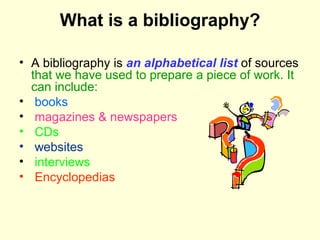G5 bibliographies
- 1. What is a bibliography? A bibliography is an alphabetical list of sources that we have used to prepare a piece of work. It can include: books magazines & newspapers CDs websites interviews Encyclopedias
- 2. Why do we write bibliographies? To acknowledge or credit our sources To give our readers information to identify and consult our sources And to make sure our information is accurate
- 3. What if we don°Øt include a bibliography? We may be accused of plagiarism ∆∞∏`◊Ô√˚ (that is, stealing another person°Øs ideas or writing); if so, we may lose some or all of the marks for our work.
- 4. Points to Remember Get into the habit of writing down the details of your sources as you work. They may not all be used in the final piece of work but it is much easier to keep a note as you go along. Use a data form or recording sheet to make sure you record all the correct information. The final bibliography needs to be in alphabetical order . The style we use at WISS is called MLA
- 5. Information to include: For books: The author°Øs surname , followed by the first name The title of the book or resource The place of publication and the publisher The year in which the book or resource was published Type of resource, e.g. Print e.g. Smith, John. Exploration and Empire , New York, Warwick Press,1999 Print.
- 6. For Magazines and Other Periodicals The author°Øs surname , followed by the first name The title of the article The title of the magazine The publication date (day, month, year) and the page number Type of resource, e.g. Print e.g. Pressman, Aaron. "Bottom Fishing in Rough Waters." BusinessWeek 29 Sept. 2008: 27. Print
- 7. For websites The author°Øs surname , followed by the first name, if available. The title of the website article. The name of the website. The publisher. Type of resource, e.g. Web The date you accessed the website e.g. Friedland, Lois. "Top 10 Natural and Wildlife Adventure Travel Trips." About.com. New York Times Company. Web. 25 Sept. 2008.
- 8. For Interviews The interviewee , surname followed by the first name, if available. The title of the interview, if available. The interviewer. The publication information, if available. Type of resource, e.g. Television e.g. Abdul, Paula. Interview by Cynthia McFadden. Nightline. ABC. WABC, New York. 23 Apr. 2009. Television.
- 9. Bibliography Academic Honesty . Cardiff : International Baccalaureate 2009. Print. Andyspinks.com. Web. 31 Oct 2010. Collins, Fiona. Academic Honesty Shanghai, 2010. Print. Collins, Fiona °∞ Writing a Bibliography by Fiona Collins on Prezi °± Prezi ®C The Zooming Presentation Editor. Web 31 Oct 2010. Gibaldi, Joseph. MLA Handbook for writers of Research papers. New York: The Modern Language Association of America, 2003. Print.








